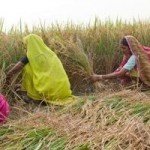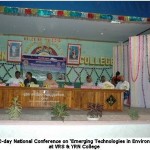
Green Harmony, an India-based organization that initiates environmentally harmonious development programmes for most disadvantaged communities, has developed a new model for tree plantation which not only improves tree cover but also provides financial incentives to women Self Help Groups (SHGs).
This model envisages a combination of conditionality and financial incentive to promote tree plantation, while it provides an income generation opportunity for the poor. Under this model, an SHG willing to start a micro enterprise could access a micro credit, if they planted and protected a certain number of trees for a few months. To incentivize protection of the planted trees, which is found to be the biggest challenge of all such tree planting initiatives, a financial incentive is available in the form of interest waivers. Thus, by contributing to environmental goal, the poor get necessary financial support to start an income generation activity, along with secondary benefits from the trees in the long run (e.g., fruits, firewood, fodder, timber, etc.).
This model has been experimented with a Women Self Help Group named “Aiswarya Dhanswaroopini Kudumbasree Ayalkoottam” at Thalavadi Grama Panchayat in Kuttanadu, Kerala. By the end of 2009, the group was given training on environmental issues and importance of planting trees. Also the terms and conditions of the “Trees for Credit” model were communicated to all members in a group meeting, as given below:
- If the SHG planted 100 trees and conserved them for 3 to 5 months, a micro loan of Rs. 20,000/- would be made available to start an income generation activity of their choice.
- The SHG should arrange the saplings or seeds themselves.
- They could plant trees of their choice; however, only native species should be planted to encourage biodiversity and to prevent mono-cropping of foreign species.
- They could plant the trees either in their own land or in any public place.
- They should repay the loan at the rate of Rs. 1,000/- per month for 20 months.
- As long as they protect all the trees during the loan period, they need not pay any interest. Otherwise, depending on the survival rate of the trees, they have to pay interest (if 80% percent of trees survive, interest would be 5%, and if 60% survive, it would be 10%, etc.).
- They should make a public pledge that no trees would be cut in future unless they plant two new trees and conserve them for at least one year.

Later, each of the members planted 5 to 10 trees totaling to more than 100 trees. Most notably, this decentralized approach resulted in considerable diversity of plants: out of the 100 trees planted, there are more than 20 types of species. Also the women tended to choose more fruit trees expecting additional benefits from the trees. After verifying the plants by a community researcher of Green Harmony, the SHG was provided a loan of Rs. 20,000/- in the month of April 2010. With this capital, the SHG has started a petty business of household provisions by purchasing provisions from whole-sale dealer and selling it locally with 10 percent margin. Thus, the pilot programme not only resulted in increased tree cover and carbon sequestration, but also provided an additional income source for the rural women.
This model has a number of positive outcomes:
- Increase in tree cover that contributes to carbon sequestration (one SHG can sequestrate one tonne carbon every year),
- Availability of zero/low interest loan for SHGs to start income generation activities,
- Improvement of natural capital base of poor communities,
- Improvement of environmental awareness, and
- An excellent platform for initiating grassroots adaptation initiatives.
- The trees themselves could also be an additional source of income for the SHGs.
More details of the ‘Trees For Credit’ model can be read at http://green-harmony.org/index_files/TFC.htm.
This pilot programme is now replicated in a few villages of coastal Tamil Nadu and arid Rajasthan, with the aim to fine-tune the model by learning from different contexts. With considerable interest from participating and other SHGs, it appears that this model has potential of being replicated across the country. With a financial incentive included, this model would ensure increase in tree cover while enhancing the livelihood of the poor.

About Green Harmony
Green-Harmony (GH), an India-based organization registered under the Societies Registration Act XXI 1860, strives to realise an environmentally harmonious human development model that provides equal opportunities to all. GH initiate grassroots programmes and work with most disadvantaged communities to capacitate them to cope up with adverse and changing environment, while contributing to conserve the life sustaining ecological systems.
It currently operates from four geo-cultural regions: Kuttanadu in the Vembanadu Wetland, Kanchipuram in the Coromandel Coast, Jodhpur in the Thar Desert, Wayanadu in the Western Ghats. Following ‘Bottom Up’ approaches, Green Harmony’s philosophy of operations is built on active and inclusive participation of stakeholders, right from the planning stage until evaluating impacts. Its operations are currently designed by following a strategic methodology that includes participatory action research, networking, collaborations and communication. For more details about Green Harmony, visit www.green-harmony.org.

About the Founder
Mathews Mullackal is the Chief Executive of Green Harmony. He did his bachelor’s degree in Civil Engineering from the University of Calicut, post graduate diplomas in Environmental Management and NGO Management from Annamalai University, and a Masters degree in International Development from the University of Bristol, UK. He has around ten years of work experience, mainly in water, environment and development sector in India and abroad. He has strong interest in environment and development, and believes that ‘Bottom Up’ development leading to community empowerment and emancipation of marginalized sections is essential for addressing the challenges of the present world.














